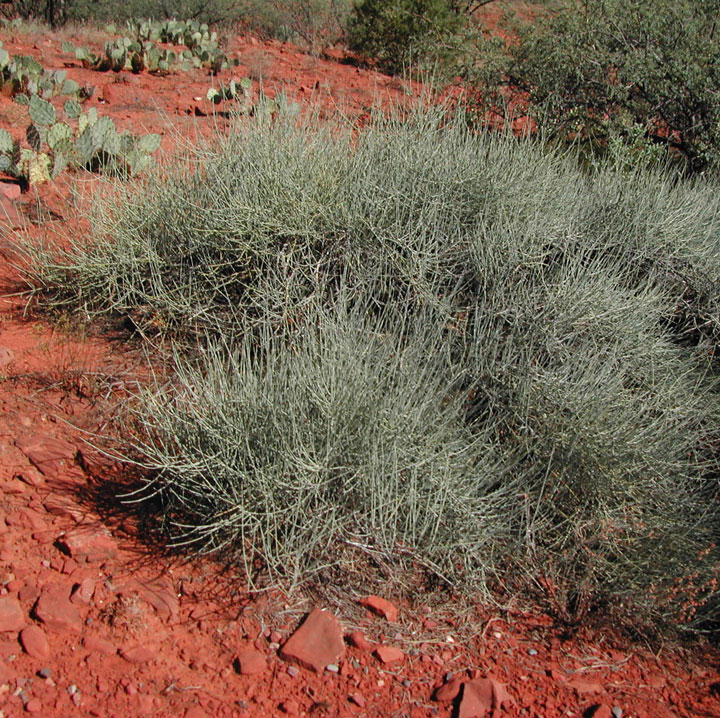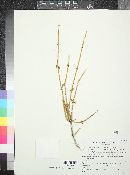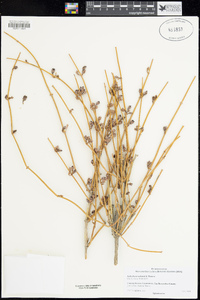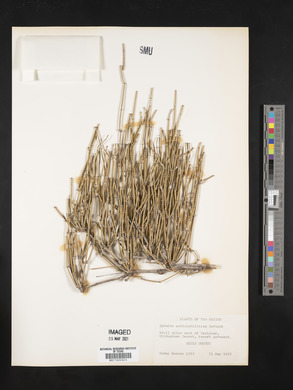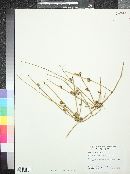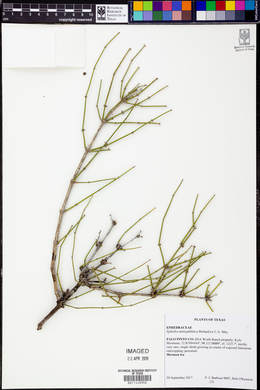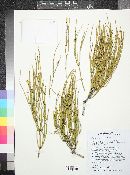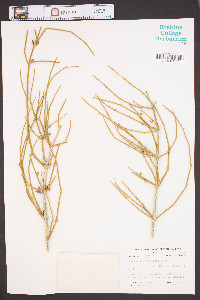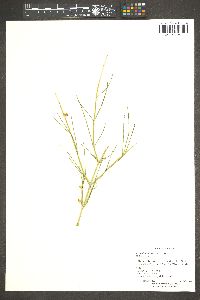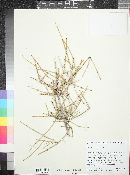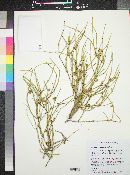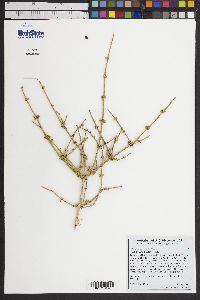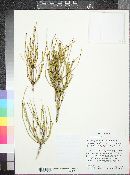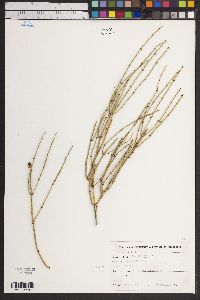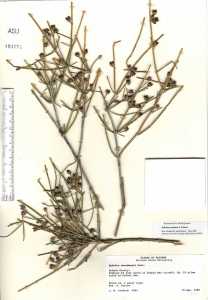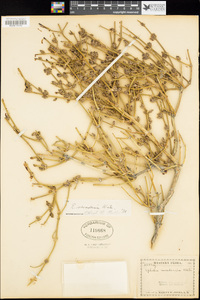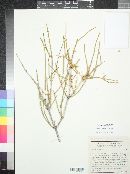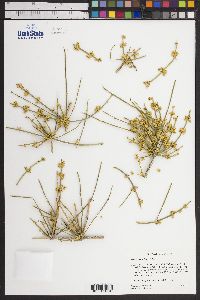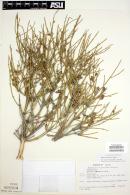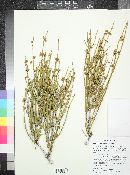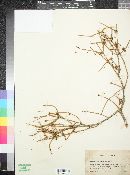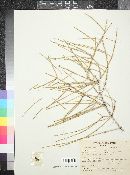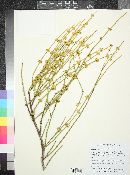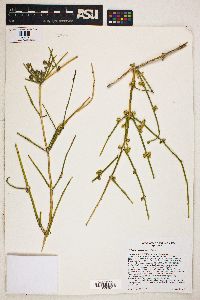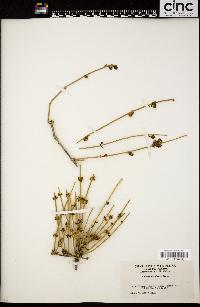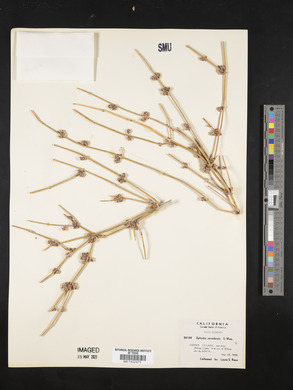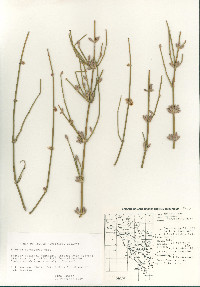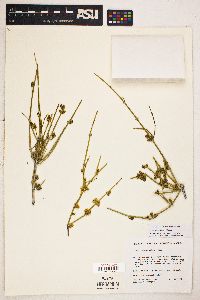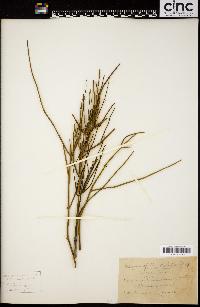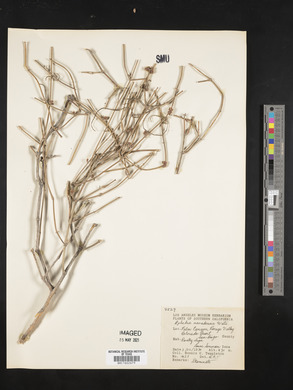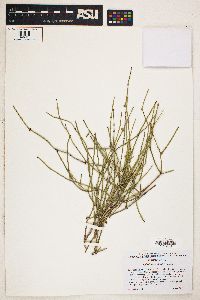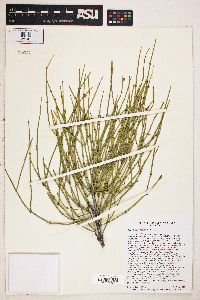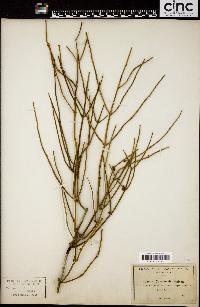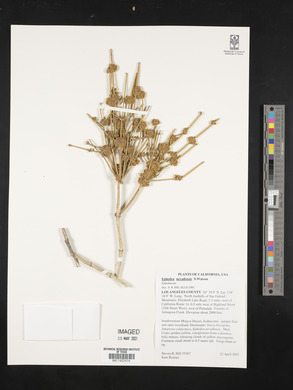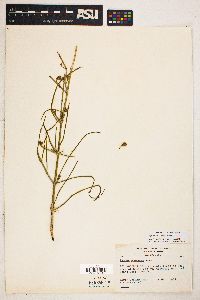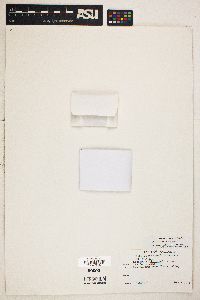Ephedra nevadensis
|
|
|
|
Family: Ephedraceae
Nevada Joint-Fir, more...Nevada jointfir, Mormon tea, Nevada ephedra, Nevada Mormon tea (es: canutillo, topopote, popotillo)
[Ephedra antisiphylitica S.Watson, moreEphedra nevadensis var. nevadensis S. Watson] |
Shrubs erect, 0.25--1.5 m. Bark gray, fissured. Branches alternate or whorled, rigid, angle of divergence about 45°. Twigs pale green, becoming yellow with age, not viscid, glaucous, with numerous longitudinal grooves; internodes 1--6 cm. Terminal buds conic, 1--3 mm, apex obtuse. Leaves opposite (rarely in whorls of 3), 2--4(--8) mm, connate to 1/2--3/4 their length; bases thickened, brown, completely deciduous; apex obtuse. Pollen cones 1--several at node, ellipsoid, 4--8 mm, sessile or on short peduncles with 2 pairs of basal bracts; bracts opposite, 5--9 pairs, yellow to light brown, obovate, 3--4 × 2--3 mm, membranous; bracteoles slightly exceeding bracts; sporangiophores 3--5 mm, exserted to 1/4--1/2 their length, with 6--9 sessile to short-stalked (less than 1 mm) microsporangia. Seed cones 1--several at node, nearly globose, 5--11 mm, on long peduncles, with 1--2 pairs of basal bracts; bracts opposite, 3--5 pairs, nearly circular, 4--8 × 3--6 mm, herbaceous, with light brown to yellow-green center, occasionally pinkish tinged, margins entire. Seeds (1--)2, ellipsoid, 6--9 × 2--4 mm, brown, smooth. 2 n = 14, 28. Coning late winter--midspring. Dry, rocky slopes and hills, rarely in sandy flat areas; 700--1900 m; Ariz., Calif., Nev., Oreg., Utah. FNA 1993 Common Name: Nevada jointfir Duration: Perennial Nativity: Native Lifeform: Subshrub General: Shrubs erect, 0.25--1.5 m. Bark gray, fissured. Branches alternate or whorled, rigid, angle of divergence about 45-. Twigs pale green, becoming yellow with age, not viscid, glaucous, with numerous longitudinal grooves; internodes 1--6 cm. Terminal buds conic, 1--3 mm, apex obtuse. Needles: Leaves opposite (rarely in whorls of 3), 2--4(--8) mm, connate to 1/2--3/4 their length; bases thickened, brown, completely deciduous; apex obtuse. Cones: Pollen cones 1--several at node, ellipsoid, 4--8 mm, sessile or on short peduncles with 2 pairs of basal bracts; bracts opposite, 5--9 pairs, yellow to light brown, obovate, 3--4 2--3 mm, membranous; bracteoles slightly exceeding bracts; sporangiophores 3--5 mm, exserted to 1/4--1/2 their length, with 6--9 sessile to short-stalked (less than 1 mm) microsporangia. Seed cones 1--several at node, nearly globose, 5--11 mm, on long peduncles, with 1--2 pairs of basal bracts; bracts opposite, 3--5 pairs, nearly circular, 4--8 3--6 mm, herbaceous, with light brown to yellow-green center, occasionally pinkish tinged, margins entire. Seeds: Seeds (1--)2, ellipsoid, 6--9 2--4 mm, brown, smooth. Ecology: Coning late winter--midspring. Dry, rocky slopes and hills, rarely in sandy flat areas; 700--1900 m; Distribution: Ariz., Calif., Nev., Oreg., Utah. Notes: Similar to E. aspera with leaves in pairs; differs in its blue-glaucous twigs, as opposed to yellowish in E. aspera.The FNA key separates this species from E. aspera and E. fascicularis by the leaf bases, which are brown and completely deciduous in E. nevadensis; and persistent, shredding, and turning gray in the other two species. Synonyms: Ephredra antisyphilitica, Ephedra antisyphilitica var. pedunculata Editor: Hazelton pasted from FNA, no editing |

